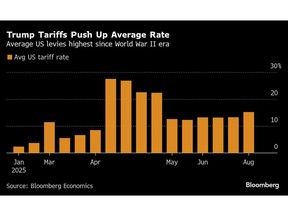
Article content
(Bloomberg) — President Donald Trump’s sweeping new tariffs officially took hold Thursday, as he barrels forward with his turbulent push to reshape global trade.
THIS CONTENT IS RESERVED FOR SUBSCRIBERS ONLY
Subscribe now to read the latest news in your city and across Canada.
- Exclusive articles from Barbara Shecter, Joe O'Connor, Gabriel Friedman, and others.
- Daily content from Financial Times, the world's leading global business publication.
- Unlimited online access to read articles from Financial Post, National Post and 15 news sites across Canada with one account.
- National Post ePaper, an electronic replica of the print edition to view on any device, share and comment on.
- Daily puzzles, including the New York Times Crossword.
SUBSCRIBE TO UNLOCK MORE ARTICLES
Subscribe now to read the latest news in your city and across Canada.
- Exclusive articles from Barbara Shecter, Joe O'Connor, Gabriel Friedman and others.
- Daily content from Financial Times, the world's leading global business publication.
- Unlimited online access to read articles from Financial Post, National Post and 15 news sites across Canada with one account.
- National Post ePaper, an electronic replica of the print edition to view on any device, share and comment on.
- Daily puzzles, including the New York Times Crossword.
REGISTER / SIGN IN TO UNLOCK MORE ARTICLES
Create an account or sign in to continue with your reading experience.
- Access articles from across Canada with one account.
- Share your thoughts and join the conversation in the comments.
- Enjoy additional articles per month.
- Get email updates from your favourite authors.
THIS ARTICLE IS FREE TO READ REGISTER TO UNLOCK.
Create an account or sign in to continue with your reading experience.
- Access articles from across Canada with one account
- Share your thoughts and join the conversation in the comments
- Enjoy additional articles per month
- Get email updates from your favourite authors
Sign In or Create an Account
or
Article content
After months of chaotic threats and reversals, higher rates for almost all US trading partners began just after midnight in New York. Trump signed the directive a week ago, but had to allow time for US Customs and Border Protection to make necessary changes to collect the levies.
Article content
Article content
Article content
Taken together, Trump’s actions will push the average US tariff rate to 15.2%, according to Bloomberg Economics estimates, well above 2.3% last year and the highest level since the World War II era.
Article content
By signing up you consent to receive the above newsletter from Postmedia Network Inc.
Article content
Following a series of turbulent negotiations, the European Union, Japan and South Korea accepted 15% duties on their products, including key exports such as automobiles which otherwise face a 25% levy. Other countries were simply assigned rates, ranging from 10% to much higher.
Article content
Some last-ditch efforts by countries to get better deals failed. The Swiss president left Washington on Wednesday without any success in lowering its 39% duty and Trump doubled levies on Indian goods to 50% starting in three weeks as a punishment for buying Russian oil.
Article content
Negotiations on higher levies on goods from three of the US’s biggest trading partners, Mexico, Canada and China, are proceeding on a separate track. Trump has also vowed to unveil soon tariffs on critical industries, including pharmaceuticals and semiconductors.
Article content
The coming months will put the predictions of both Trump and his detractors to the test: that the tariff regime will cause a seismic shift for the US economy.
Article content
Article content
Trump has pledged higher levies will slash trade deficits and push companies to move manufacturing back to the US. His critics say they could cause inflation to spiral out of control and cause shortages on store shelves.
Article content
None of those have yet come to pass, but recent economic data has indicated potential troubles lie ahead as the tariffs set in.
Article content
July employment figures showed the steepest downward revisions to US jobs growth since the Covid-19 pandemic. US economic growth slowed in the first half of the year as consumers tempered spending and companies adjusted to shifting trade policy.
Article content
Unemployment remains low and prices have not surged, as companies have so far eaten much of the costs. But some experts say consumers and businesses will end up footing the bill.
Article content
“There are signs that tougher times are around the corner. A lot of companies have been building up inventories before the tariffs went into place,” said Wendy Cutler, vice president of the Asia Society Policy Institute and a former US trade negotiator. She argued that it is “almost inevitable that prices increase” because businesses are unlikely to sustain lower margins over the long term.

.jpg) 2 hours ago
1
2 hours ago
1
 English (US)
English (US)